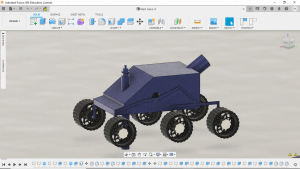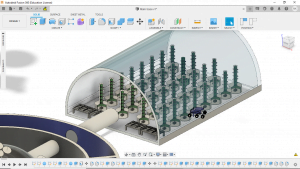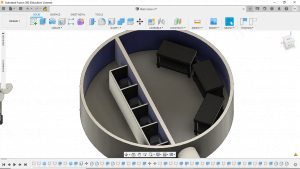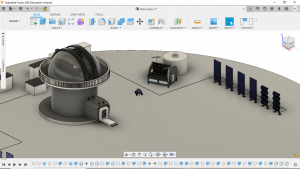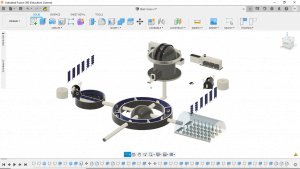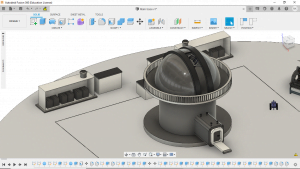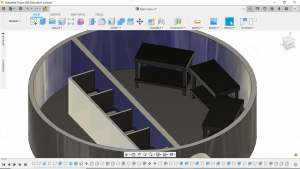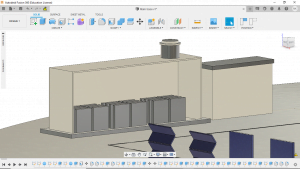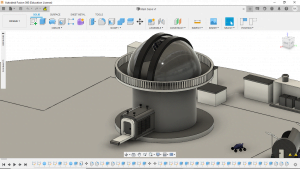Moon Camp Pioneers Gallery 2020-2021
In Moon Camp Pioneers each team’s mission is to 3D design a complete Moon Camp using Fusion 360. They also have to explain how they will use local resources, protect astronauts from the dangerous of space and describe the living and working facilities.
Team: Moon SONATA
FABLAB ILIAUNI Tbilisi Georgia 15, 16, 17
External viewer for 3d project
|
Project description
Our project is designed for the exploration and scientific, infrastructural development of the moon. Our goal is to maximize the relief of the moon. With ice extracted from the moon, we can: get water, oxygen, and fuel, also through solar panels, which are presented in the project, we will receive energy. Lunar relief also allows us to build the desired construction with a 3D printer and materials extracted from the moon. The atmosphere will be helped by a system of hydroponics, through which we will convert the carbon dioxide released by humans into oxygen, and the greenhouse, among other functions, will help us in the production of food. To simplify life on the moon, we’ll use rovers, which will perform the function of transport, and for ice transportation, we’ll use a special machine through which we’ll be able to transport ice to the reservoir. We will need two preparation flights with Ariane 6 and astronauts as well as chickens will arrive with the fourth flight. Above the crater, there is an observatory, a cosmodrome, an orangery with its water reservoirs, rovers, solar panels, and evacuation exits. below it will be a residential-research center, which consists of the following rooms: toilet, warehouse, bedroom, research room with modern science equipment. And there will also be an additional greenhouse under the base. In conclusion, our Moon SONATA base will be a multifunctional place for exploring and living, we hope that we will help future generations in exploring something as huge as the universe. |
|||
|
Where do you want to build your Moon Camp?
The SETI Institute announced that they had identified a series of small pits in a crater near the Moon’s northern pole. Because of the lower gravity on the Moon, lava tubes should be kilometers across. Which is big enough for building our base. Camp will be located on the northeastern floor of Philolaus Crater where the lunar tubes have been discovered. In the eternally shadowed craters, there could be large deposits of water collected below that colonists could harvest. Main base and water Reservoir will be underground, while observatory and moving vehicles stay on the moon’s surface. The North pole also has another advantage of having solar power nearby. That location would give us access to permanent sunlight, that we would use for power generation and production stations for 3d printing. Later we plan to evolve and produce resources,products that can be shipped to earth, and used for great reasons. How do you plan to build your Moon Camp? Describe the techniques and materials you would use.
To construct the base, we would send modular parts via payload rockets. The parts would then be used to construct different structures and vehicles. We’ll also bring a robot called “Razor” designed to harvest lunar soil so that astronauts can build with it. Regolith will be combined with polymers like plastics or resins (which will be recycled from crew members’ waste) to create the raw material for printing. We can make that polymer composite concrete either using the granular material right off the ground, or granular material can be heated up and drawn out into a glass fiber which makes the material really strong, like carbon fiber or Kevlar. This way we can do any kind of simple structure that the crew might need, whether it’s a habitat, a blast wall, or a road, or maybe a hangar. Also furniture or any other kind of things they might need. Our country has a big history of making svan ( region in Georgia ) hats out of felted wool, which is one of the important traditions of the Svan people’s cultural identity. The material itself which the hats are made out of makes an excellent thermal barrier. Our ancestors used this material to sleep in the snow during winter times. The millions of tiny air pockets can trap air, thus creating a thermal barrier from outside temperatures. This is why we have decided to use one of our national symbol’s materials, as a thermal insulator for our moon base. The environment on the Moon is very dangerous for the astronauts. Explain how your Moon Camp will protect them.
By living underground, in the lunar tunnels, we have the advantage of hiding from the surface radiation, micrometeorite bombardment, and extreme temperatures. These natural tunnels will save them the hard work of needing to dig the tunnel. The roofs on these tunnels fluctuate from 10 to 90 meters. This would be enough to protect us from solar and galactic cosmic radiation. By sealing off the interior of the lava tube, we’ll prevent lunar dust (which is hazardous to electronics) from getting inside the base. There’ll be an artificial day and night cycle, this makes sure that the plants/animals behave normally and crew members don’t have disturbed sleep. The walls will contain stable levels of oxygen and humidity so that all organisms have a habitat to survive in. To ensure that crew stays mentally healthy, contact between family will be kept and each person will be allowed two kilograms of personal belongings. Explain how your Moon Camp will provide the astronauts with:
|
|||
|
Water
|
Food
|
Electricity
|
Air
|
|
Water that we’ll take from earth is an exhaustible resource. But we’ll be close to the north pole where the ice has been discovered. There we’ll drill down with planetary volatile extractor PVEx) and then heat the core downhole. There’re embedded heaters on the inside of the coring string, which forces the volatiles to sublimate and go up the middle of the drill string. The water will be in a form of ice. So, after collecting and storing ice in a water tank solar power will be collected and beamed down with a magnifying glass so the water can be transformed from ice to vapor. Later this gas will go out through cold pipes, that way we can trap it with a cold surface, and it becomes water. We’ll be left with a large amount of water which then would be used for drinking, growing agriculture,hygiene,and making rocket fuel. |
As on Earth, space food comes in disposable containers. coffee, tea, orange juice, seafood, candy – all of them will be brought from the Earth. Furthermore, we have a greenhouse, which creates better, optimum conditions for our plants to grow. There will be grown potatoes, which contains a good amount of carbs and fiber, as well as vitamin C, vitamin B6, potassium and manganese; also beans for B vitamin, Cabbages for vitamin C, A and K. Besides, we bring ten chicken with us, consequently, we will be provided with eggs, which are important for growth, energy metabolism, red blood cell development, vision, and the healthy functioning of the nervous system. |
Electricity is a crucial resource as it allows the team to live comfortably, safely operate the station, and perform scientific experiments. Rays are the best source of energy for spacecraft, hence, we will use solar panels. The Sun is the main energy source for satellites, which is why all satellites have solar panel arrays mounted on them. Solar arrays are made of thousands of solar cells, which are made of silicon – a material that allows sunlight to be turned into electrical current. |
The air and water on the Space Station came from Earth. Water is also used to produce oxygen. We will make oxygen by running electricity through water. Using a process called electrolysis, which involves running electricity through water, astronauts and cosmonauts will be able to split the oxygen from the hydrogen. In addition, The greenhouse full of plants will produce air. But still mostly will rely on oxygen cylinders brought from Earth. |
|
Explain what would be the main purpose of your Moon Camp (for example: commercial, scientific, and/or tourist purposes).
There are different motives why we want to go to the moon. First, we want to observe other planets from the moon. Observing the universe from the moon we will know more about the galaxy. Besides, there is no atmosphere on the moon and thus natural disasters such as thunder, heavy rains cannot interfere with the examination process of other planets from the moon. Thus, carrying a telescope with us will be a good idea. Also, we would like to investigate if the soil of the moon is useful for agricultural purposes, such as growing plants using the moon’s water if there exists any. Last but not least, our final desire is to discover if there is any possibility to live in this area without any difficulties. This is our intention for going to the moon and we hope we can discover new opportunities there. |
|||
|
Describe a day on the Moon for your Moon Camp astronaut crew.
After the astronauts wake up, they dress up, clothes usually are disposable which get, replaced once every three days, to cut down on water usage. They brush their teeth and either shower or wipe themselves with a wet cloth. To minimize resupply needs, our base is designed to recycle as much as possible. Wastewater from urine and moisture condensed from the air will either be purified and reused directly or broken down by electrolysis to provide fresh oxygen. Each astronaut gets three meals within a day, which are nutritionally balanced and rich in calories so that they can start and end their day with a great meal after a hard day of working and exploring. After breakfast they have to attend the morning conference with the earth stations to discuss their daily assignments, either supervising experiments, taking care of plants, or exploring the moon’s surface. On the lunar surface, they will do exploring around a riding rover with an attached astronauts chair, improve outside of camp, search for interesting places. Inside base astronauts will be able to conduct scientific experiments and monitor Moon Camp – pass commands for rovers, create and test designs for production station 3D printers. One substance that is not recycled is solid human waste: it is collected, compressed, and stored for disposal. Generally, days on the moon will be busy – and when heavy equipment such as EVA suits has to be moved, they can be exhausting, too. Just because a crate of scientific gear is weightless doesn’t mean that it has lost its mass. Astronauts have to pull and push against inertia, and they are often working in strange positions for which human muscles are not well adapted. Staying fit is very important to counteract muscle loss caused by minimal strain due to low gravitation. Everyday crew members must exercise for two hours. The base is fully supplied with exercising equipment. The crew will have some free time before bed. These hours are precious: this is when they might write emails home, watch DVDs, read books or transmit just for fun on ham radio. Before the lunar night, the crew will assess the resources and energy stored within the base and reflect on the day. During the night they will watch the levels of hydrogen and if needed turn off some systems to ensure the base keeps power for critical systems like life-support. |
|||


